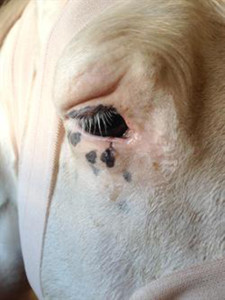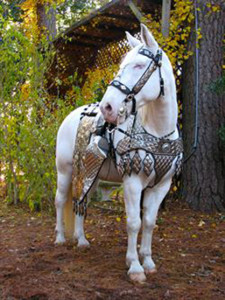Hi-Yo Silver! Equine Star Treated For Squamous Cell Carcinoma of the Eye
Penn Vet Extra by: Louisa Shepard
Silver must wear a mask, just like his owner, the man who calls himself the Lone Ranger.
Diagnosed with squamous cell carcinoma of the eye, the Tennessee Walking Horse has undergone surgery at Penn Vet’s New Bolton Center to remove multiple cancerous lesions.
To prevent a recurrence, when this very white horse goes outside, he must wear a mask to protect his light-pigmented skin from the sun’s ultraviolet rays.
“Silver’s mask is a different color than mine, and it covers his whole face,” said Silver’s owner, Garry Cherricks, of Salisbury, Maryland. “We have him wearing the mask to protect his sensitive eyes.”
This specific type of cancer is associated with UV light exposure, said Dr. Nicole Scherrer, Ophthalmology Resident at New Bolton Center, who treated Silver.
“It’s like us going out in the sun unprotected,” Scherrer said. “The areas around Silver’s eyes, nose, and sheath have minimal hair and are lightly pigmented. Silver is more likely to develop squamous cell carcinoma than other horses because of that light pigmentation.”
When Silver steps outside, he must wear a mask with UV light protection of greater than 75 percent, Scherrer said. “Preventing recurrence and new growth of cancer are our main goals for Silver now,” she said.
Although Cherricks has used sunblock on Silver’s face, Scherrer said sunblock only lasts a short period of time and needs to be applied quite frequently, just like for humans. And sunblock cannot be applied to the lid margins where Silver developed his cancerous lesions, she said.
Now Silver will wear the mask at all times, Cherricks said, except during performances.
Silver is a Star
Silver performs in parades, festivals, rodeos, and other events with his owner, who calls himself John Reid, the name of the character in the Lone Ranger television show and movies. Silver stands 16.2 hands, and when performing, wears tack lavishly embellished with silver, just like the screen star.
For the past several years, the pair has appeared in local Christmas parades in West Chester and Coatesville, PA, as well as Baltimore, MD. They also are participants in the Fourth of July parade in Washington, DC.
Highly trained, the 13-year-old gelding can perform tricks on cue, such as shaking his head yes and no, counting by pawing the ground, and saluting the flag by lifting his leg.
Even now while in recovery, Silver is in “great spirits,” Cherricks said. “He is active, eating well, and he’s still eager to do his tricks.”
Unfortunately, the pair had to cancel their appearances in the parades during this past holiday season.
Silver’s Surgery
Silver’s primary veterinarian diagnosed the condition affecting his eyes, and urged Cherricks to take Silver to New Bolton Center. Three lesions on Silver’s left upper eyelid, left lower eyelid, and right lower eyelid were suspicious.
“The best way to treat this condition is surgical excision, which means cutting out the lesions,” Scherrer said. “The hardest thing with lesions on the eyelid margin is that we have to reconstruct it to prevent damage to the cornea.”
The eyelid margin is the area where the eyelashes are located. Without an eyelid margin, a horse cannot maintain the eye. Although the condition isn’t painful when the lesions are small, as they enlarge, the skin stretches and the lesions can rub the cornea, which can be painful.
“The best approach is to remove the lesions when they are small,” Scherrer said. “There’s only so much reconstruction we can do because the skin around the face is adhered tightly to the skull. As the lesion gets bigger, it becomes more difficult to do surgery.“
Scherrer performed surgery on Silver in early November. She removed the lesions in the upper and lower eyelids of the left eye and then performed a reconstruction called an H-plasty, which involves taking the skin from above or below the lesion and pulling it up to create a new eyelid margin. On the right lid she was able to do a simpler procedure, called a wedge resection, removing the lesion and making the margin a bit shorter. Both procedures went well, she said.
However, the recovery was complicated. Silver’s left eyelid and nose bled after surgery. Once the bleeding stopped, he went home with a head bandage in place. Unfortunately, he rubbed his head and injured the surgical site for the left lower eyelid. Eventually the left lower eyelid separated from the blood supply, causing that skin to die.
“It is not common, but it is a complication reported with this surgery,” Scherrer said.
Silver returned to New Bolton Center, where clinicians managed the wound. Silver wore a head bandage, as well as a neck cradle so he couldn’t rub. The affected area was cleaned daily and clinicians monitored the healing.
Once the bandage came off and the wound was stable, Silver was moved to a nearby barn for continued recovery. Although the pair missed the holiday parades, Silver made it home just in time for Christmas.
Silver’s Recovery
Scherrer said that for Silver to make a full recovery, the tissue must continue to heal, and the area has to be protected from sun exposure. Cherricks sends her photos every two weeks so she can monitor the healing progress. Scherrer said the progress is “great” and she expects Silver to be fully healed in about two months.
Protection from the sun is key for any light-skinned horse, Scherrer said. Especially susceptible breeds are Haflingers, Appaloosas, Paints, and Belgians.
“For all horses with pink skin around eyes, a UV light protective mask should be worn,” Scherrer said. “If owners see any masses, they should have them treated in the early stages to have the best chance at success.”
Cherricks said he has been “very pleased” with the care Silver has received at New Bolton Center.
“I just can’t say enough about what everyone has done for Silver. We appreciate it,” Cherricks said. “Everybody I came in contact with at New Bolton Center was so gracious, considerate, helpful, sympathetic, and compassionate.”
The Lone Ranger and Silver are scheduled to appear for the sixth time in the Fourth of July parade in Washington, DC, this summer. Hi-Yo, Silver! Away!













